Evaluating Human Factors in Aviation Safety: A Comprehensive Study
VerifiedAdded on 2020/04/15
|70
|16034
|30
AI Summary
The purpose of this research assignment is to investigate the critical role that human factors play in ensuring aviation safety. By examining key concepts such as resilience engineering, distributed situation awareness, and sociotechnical systems failure, students will develop a nuanced understanding of how these elements contribute to both preventing and analyzing aviation accidents. The research will involve an evaluation of various methodologies from qualitative to quantitative approaches as outlined in the provided references. Students are expected to critically analyze case studies like Air France 447 and consider broader implications for enhancing safety culture in air traffic management. Ultimately, this assignment aims to equip students with a holistic view of how human factors intersect with technological systems to maintain safe aviation operations.
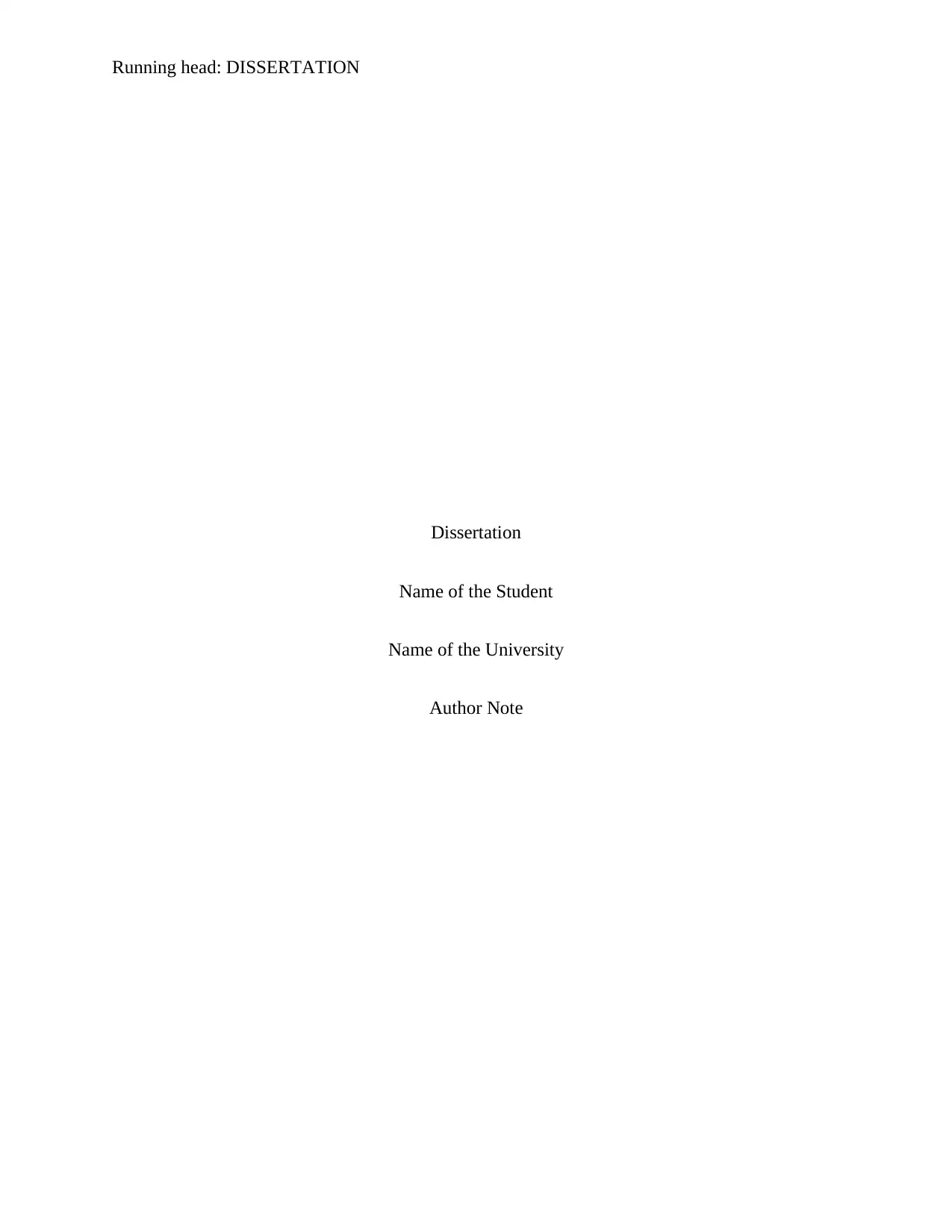
Running head: DISSERTATION
Dissertation
Name of the Student
Name of the University
Author Note
Dissertation
Name of the Student
Name of the University
Author Note
Paraphrase This Document
Need a fresh take? Get an instant paraphrase of this document with our AI Paraphraser
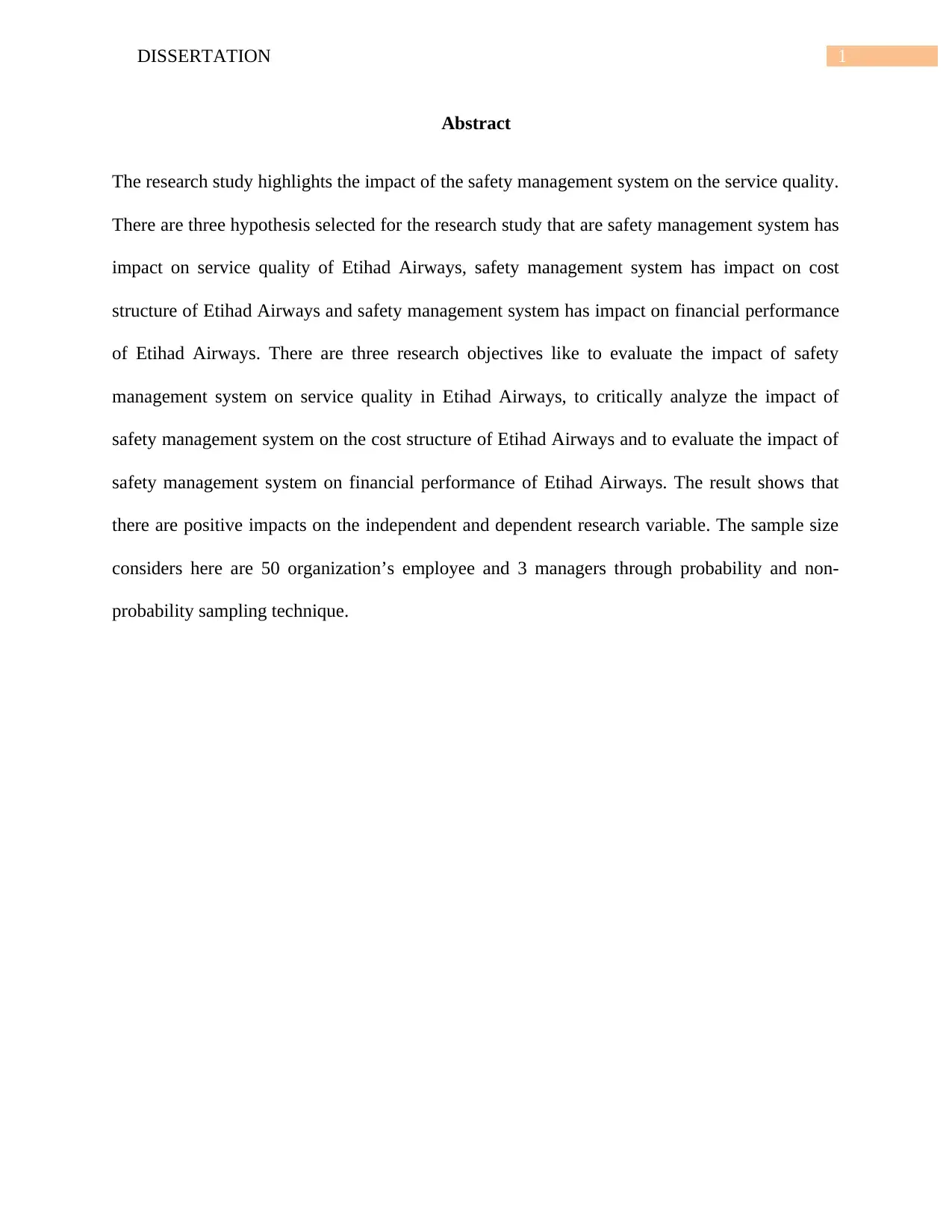
1DISSERTATION
Abstract
The research study highlights the impact of the safety management system on the service quality.
There are three hypothesis selected for the research study that are safety management system has
impact on service quality of Etihad Airways, safety management system has impact on cost
structure of Etihad Airways and safety management system has impact on financial performance
of Etihad Airways. There are three research objectives like to evaluate the impact of safety
management system on service quality in Etihad Airways, to critically analyze the impact of
safety management system on the cost structure of Etihad Airways and to evaluate the impact of
safety management system on financial performance of Etihad Airways. The result shows that
there are positive impacts on the independent and dependent research variable. The sample size
considers here are 50 organization’s employee and 3 managers through probability and non-
probability sampling technique.
Abstract
The research study highlights the impact of the safety management system on the service quality.
There are three hypothesis selected for the research study that are safety management system has
impact on service quality of Etihad Airways, safety management system has impact on cost
structure of Etihad Airways and safety management system has impact on financial performance
of Etihad Airways. There are three research objectives like to evaluate the impact of safety
management system on service quality in Etihad Airways, to critically analyze the impact of
safety management system on the cost structure of Etihad Airways and to evaluate the impact of
safety management system on financial performance of Etihad Airways. The result shows that
there are positive impacts on the independent and dependent research variable. The sample size
considers here are 50 organization’s employee and 3 managers through probability and non-
probability sampling technique.
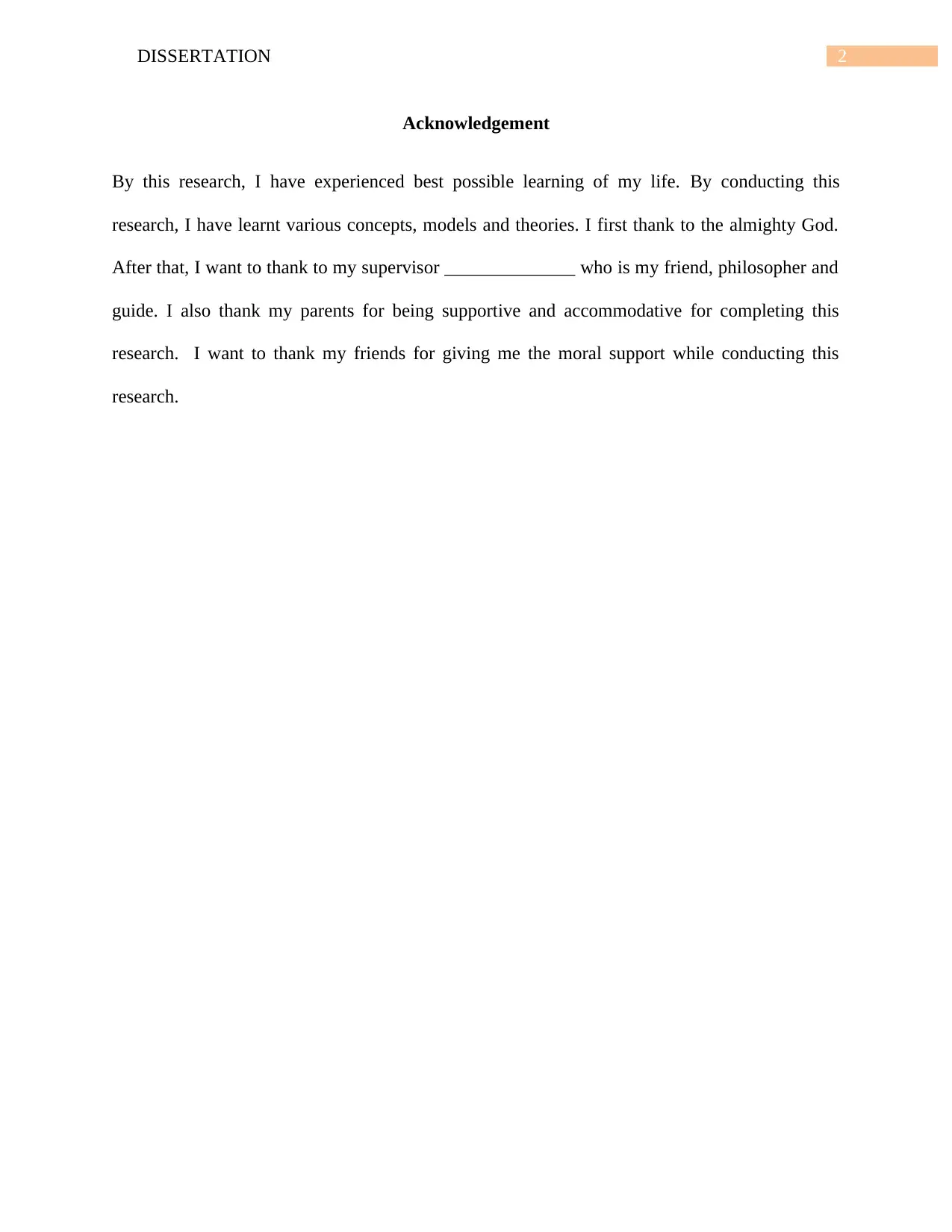
2DISSERTATION
Acknowledgement
By this research, I have experienced best possible learning of my life. By conducting this
research, I have learnt various concepts, models and theories. I first thank to the almighty God.
After that, I want to thank to my supervisor ______________ who is my friend, philosopher and
guide. I also thank my parents for being supportive and accommodative for completing this
research. I want to thank my friends for giving me the moral support while conducting this
research.
Acknowledgement
By this research, I have experienced best possible learning of my life. By conducting this
research, I have learnt various concepts, models and theories. I first thank to the almighty God.
After that, I want to thank to my supervisor ______________ who is my friend, philosopher and
guide. I also thank my parents for being supportive and accommodative for completing this
research. I want to thank my friends for giving me the moral support while conducting this
research.
⊘ This is a preview!⊘
Do you want full access?
Subscribe today to unlock all pages.

Trusted by 1+ million students worldwide
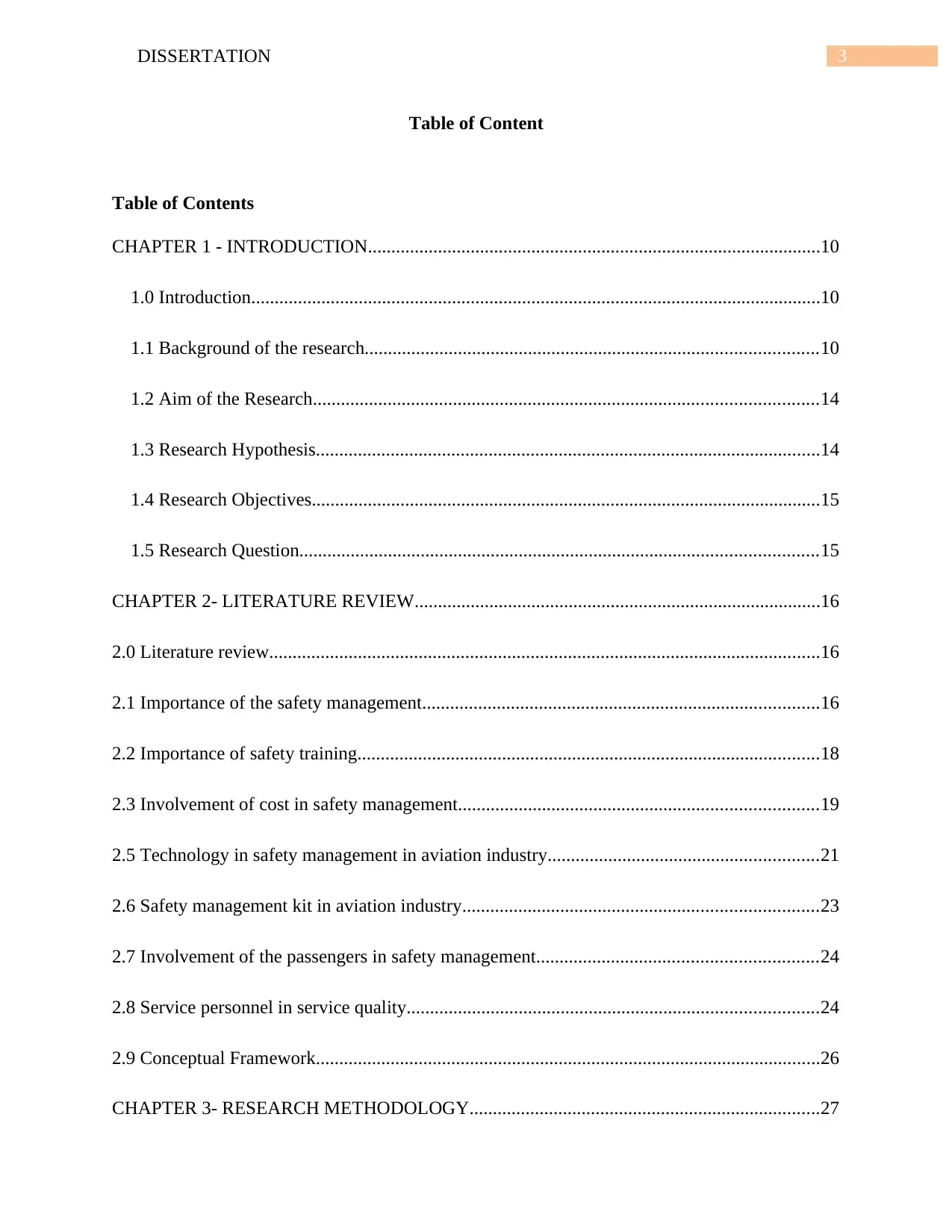
3DISSERTATION
Table of Content
Table of Contents
CHAPTER 1 - INTRODUCTION.................................................................................................10
1.0 Introduction..........................................................................................................................10
1.1 Background of the research.................................................................................................10
1.2 Aim of the Research............................................................................................................14
1.3 Research Hypothesis............................................................................................................14
1.4 Research Objectives.............................................................................................................15
1.5 Research Question...............................................................................................................15
CHAPTER 2- LITERATURE REVIEW.......................................................................................16
2.0 Literature review......................................................................................................................16
2.1 Importance of the safety management.....................................................................................16
2.2 Importance of safety training...................................................................................................18
2.3 Involvement of cost in safety management.............................................................................19
2.5 Technology in safety management in aviation industry..........................................................21
2.6 Safety management kit in aviation industry............................................................................23
2.7 Involvement of the passengers in safety management............................................................24
2.8 Service personnel in service quality........................................................................................24
2.9 Conceptual Framework............................................................................................................26
CHAPTER 3- RESEARCH METHODOLOGY...........................................................................27
Table of Content
Table of Contents
CHAPTER 1 - INTRODUCTION.................................................................................................10
1.0 Introduction..........................................................................................................................10
1.1 Background of the research.................................................................................................10
1.2 Aim of the Research............................................................................................................14
1.3 Research Hypothesis............................................................................................................14
1.4 Research Objectives.............................................................................................................15
1.5 Research Question...............................................................................................................15
CHAPTER 2- LITERATURE REVIEW.......................................................................................16
2.0 Literature review......................................................................................................................16
2.1 Importance of the safety management.....................................................................................16
2.2 Importance of safety training...................................................................................................18
2.3 Involvement of cost in safety management.............................................................................19
2.5 Technology in safety management in aviation industry..........................................................21
2.6 Safety management kit in aviation industry............................................................................23
2.7 Involvement of the passengers in safety management............................................................24
2.8 Service personnel in service quality........................................................................................24
2.9 Conceptual Framework............................................................................................................26
CHAPTER 3- RESEARCH METHODOLOGY...........................................................................27
Paraphrase This Document
Need a fresh take? Get an instant paraphrase of this document with our AI Paraphraser

4DISSERTATION
3.0 Research Methodology........................................................................................................27
3.1 Research Philosophy........................................................................................................28
3.2 Research Approach..........................................................................................................31
3.3 Data collection.................................................................................................................32
3.4 Data Analysis...................................................................................................................33
3.5 Sampling..........................................................................................................................34
3.6 Reliability and Validity....................................................................................................35
3.7 Ethical consideration.......................................................................................................35
CHAPTER 4- FINDINGS AND ANALYSIS...............................................................................37
4.0 Findings and analysis...........................................................................................................37
4.1 Quantitative Question......................................................................................................37
4.1.1 Demographics questions...............................................................................................37
4.1.2 Quantitative Question on safety management system......................................................38
4.1.3 Quantitative Question on service quality..........................................................................43
4.1.4 Quantitative Question on cost structure............................................................................46
4.1.5 Quantitative Question on financial performance..............................................................48
4.2 Qualitative Questions.......................................................................................................56
4.3 Airplane crash reports......................................................................................................59
CHAPTER 5 - CONCLUSION AND RECOMMENDATION....................................................61
5.0 Conclusion...........................................................................................................................61
3.0 Research Methodology........................................................................................................27
3.1 Research Philosophy........................................................................................................28
3.2 Research Approach..........................................................................................................31
3.3 Data collection.................................................................................................................32
3.4 Data Analysis...................................................................................................................33
3.5 Sampling..........................................................................................................................34
3.6 Reliability and Validity....................................................................................................35
3.7 Ethical consideration.......................................................................................................35
CHAPTER 4- FINDINGS AND ANALYSIS...............................................................................37
4.0 Findings and analysis...........................................................................................................37
4.1 Quantitative Question......................................................................................................37
4.1.1 Demographics questions...............................................................................................37
4.1.2 Quantitative Question on safety management system......................................................38
4.1.3 Quantitative Question on service quality..........................................................................43
4.1.4 Quantitative Question on cost structure............................................................................46
4.1.5 Quantitative Question on financial performance..............................................................48
4.2 Qualitative Questions.......................................................................................................56
4.3 Airplane crash reports......................................................................................................59
CHAPTER 5 - CONCLUSION AND RECOMMENDATION....................................................61
5.0 Conclusion...........................................................................................................................61
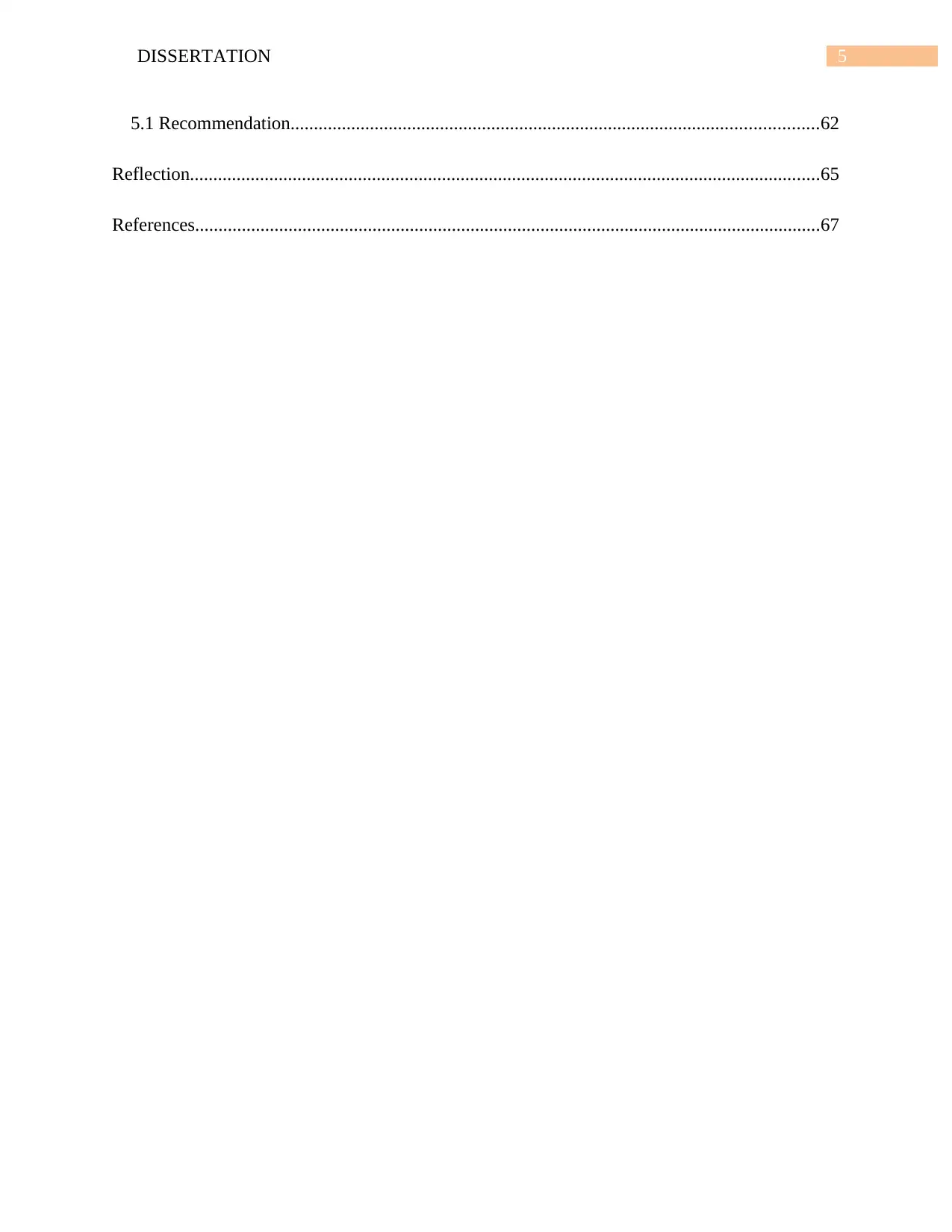
5DISSERTATION
5.1 Recommendation.................................................................................................................62
Reflection.......................................................................................................................................65
References......................................................................................................................................67
5.1 Recommendation.................................................................................................................62
Reflection.......................................................................................................................................65
References......................................................................................................................................67
⊘ This is a preview!⊘
Do you want full access?
Subscribe today to unlock all pages.

Trusted by 1+ million students worldwide
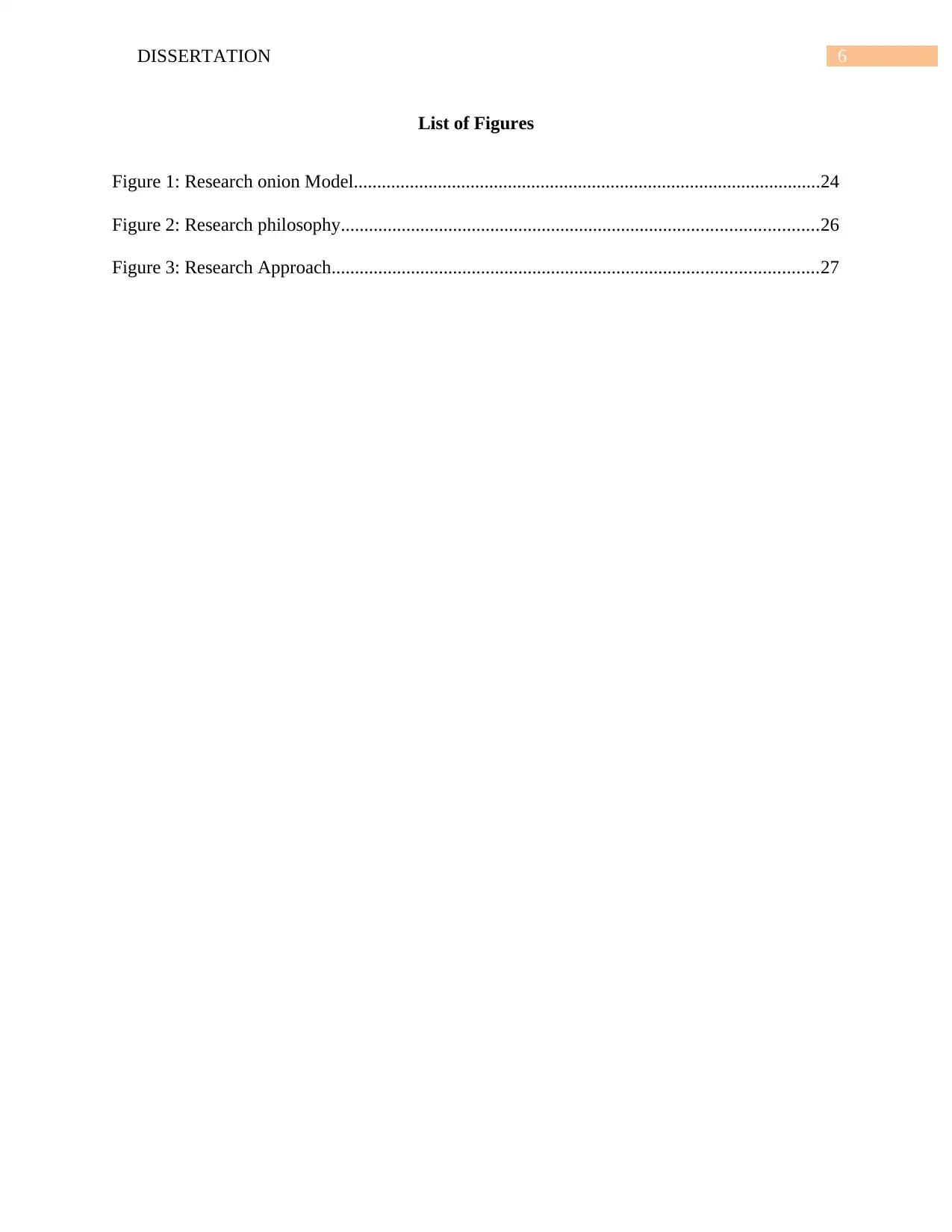
6DISSERTATION
List of Figures
Figure 1: Research onion Model....................................................................................................24
Figure 2: Research philosophy......................................................................................................26
Figure 3: Research Approach........................................................................................................27
List of Figures
Figure 1: Research onion Model....................................................................................................24
Figure 2: Research philosophy......................................................................................................26
Figure 3: Research Approach........................................................................................................27
Paraphrase This Document
Need a fresh take? Get an instant paraphrase of this document with our AI Paraphraser
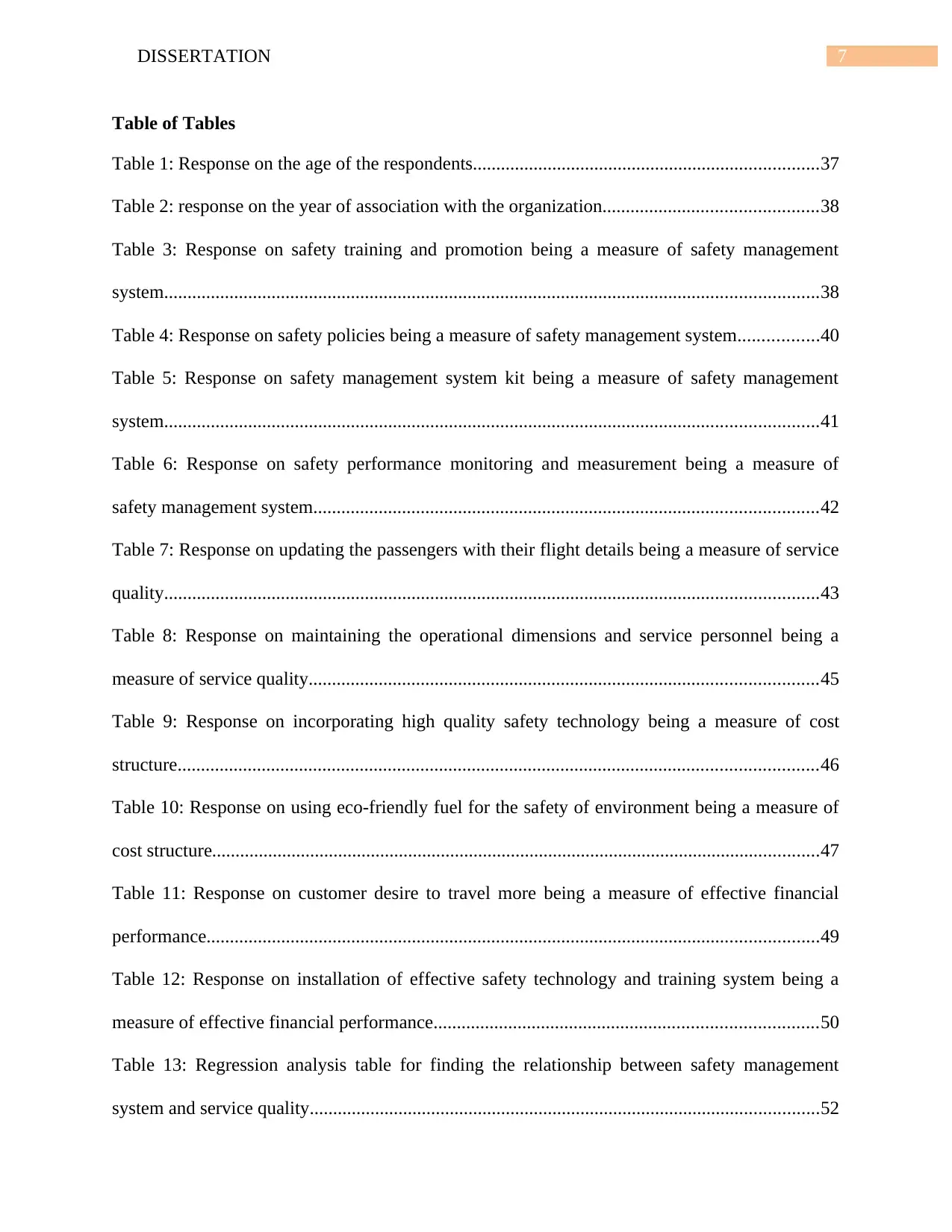
7DISSERTATION
Table of Tables
Table 1: Response on the age of the respondents..........................................................................37
Table 2: response on the year of association with the organization..............................................38
Table 3: Response on safety training and promotion being a measure of safety management
system............................................................................................................................................38
Table 4: Response on safety policies being a measure of safety management system.................40
Table 5: Response on safety management system kit being a measure of safety management
system............................................................................................................................................41
Table 6: Response on safety performance monitoring and measurement being a measure of
safety management system............................................................................................................42
Table 7: Response on updating the passengers with their flight details being a measure of service
quality............................................................................................................................................43
Table 8: Response on maintaining the operational dimensions and service personnel being a
measure of service quality.............................................................................................................45
Table 9: Response on incorporating high quality safety technology being a measure of cost
structure.........................................................................................................................................46
Table 10: Response on using eco-friendly fuel for the safety of environment being a measure of
cost structure..................................................................................................................................47
Table 11: Response on customer desire to travel more being a measure of effective financial
performance...................................................................................................................................49
Table 12: Response on installation of effective safety technology and training system being a
measure of effective financial performance..................................................................................50
Table 13: Regression analysis table for finding the relationship between safety management
system and service quality.............................................................................................................52
Table of Tables
Table 1: Response on the age of the respondents..........................................................................37
Table 2: response on the year of association with the organization..............................................38
Table 3: Response on safety training and promotion being a measure of safety management
system............................................................................................................................................38
Table 4: Response on safety policies being a measure of safety management system.................40
Table 5: Response on safety management system kit being a measure of safety management
system............................................................................................................................................41
Table 6: Response on safety performance monitoring and measurement being a measure of
safety management system............................................................................................................42
Table 7: Response on updating the passengers with their flight details being a measure of service
quality............................................................................................................................................43
Table 8: Response on maintaining the operational dimensions and service personnel being a
measure of service quality.............................................................................................................45
Table 9: Response on incorporating high quality safety technology being a measure of cost
structure.........................................................................................................................................46
Table 10: Response on using eco-friendly fuel for the safety of environment being a measure of
cost structure..................................................................................................................................47
Table 11: Response on customer desire to travel more being a measure of effective financial
performance...................................................................................................................................49
Table 12: Response on installation of effective safety technology and training system being a
measure of effective financial performance..................................................................................50
Table 13: Regression analysis table for finding the relationship between safety management
system and service quality.............................................................................................................52
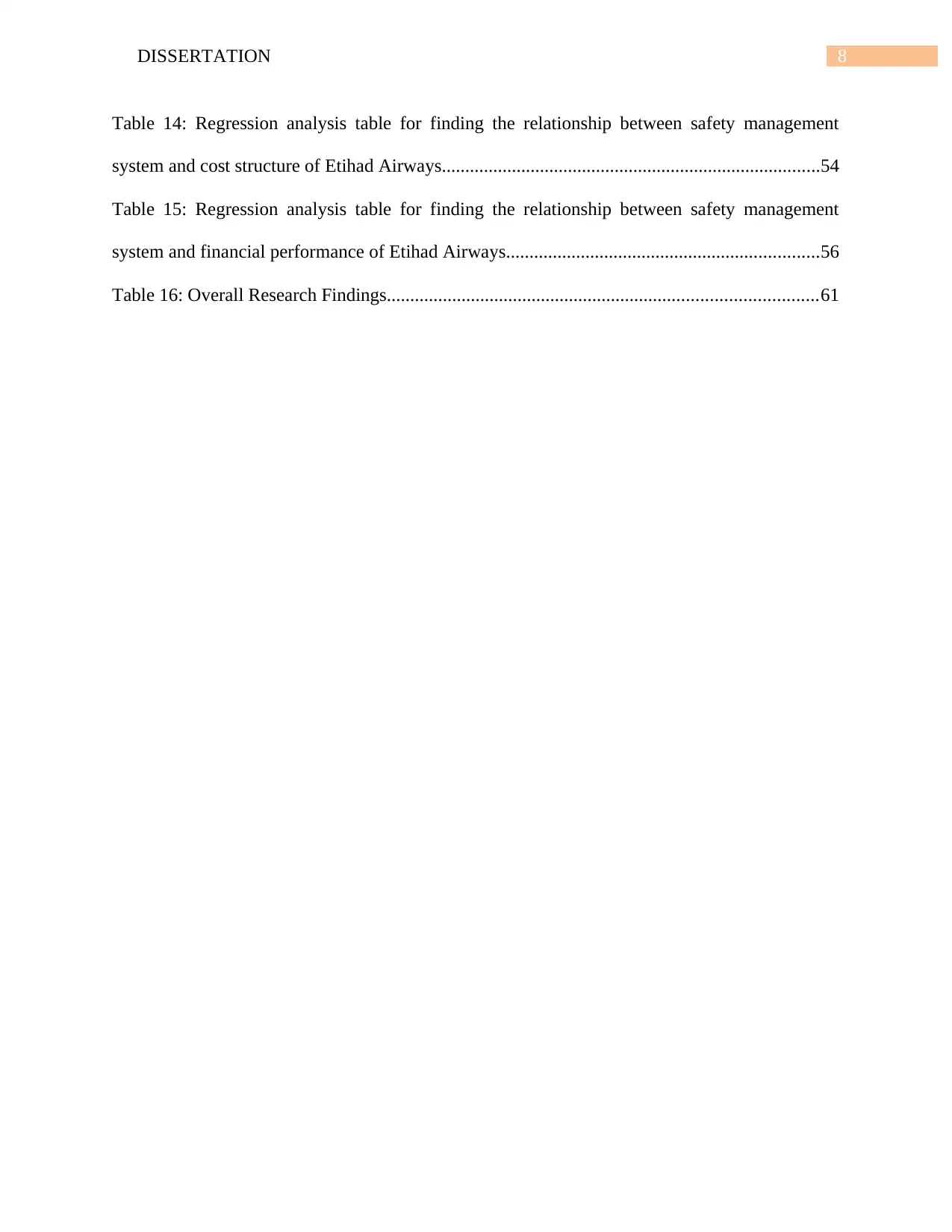
8DISSERTATION
Table 14: Regression analysis table for finding the relationship between safety management
system and cost structure of Etihad Airways.................................................................................54
Table 15: Regression analysis table for finding the relationship between safety management
system and financial performance of Etihad Airways...................................................................56
Table 16: Overall Research Findings............................................................................................61
Table 14: Regression analysis table for finding the relationship between safety management
system and cost structure of Etihad Airways.................................................................................54
Table 15: Regression analysis table for finding the relationship between safety management
system and financial performance of Etihad Airways...................................................................56
Table 16: Overall Research Findings............................................................................................61
⊘ This is a preview!⊘
Do you want full access?
Subscribe today to unlock all pages.

Trusted by 1+ million students worldwide
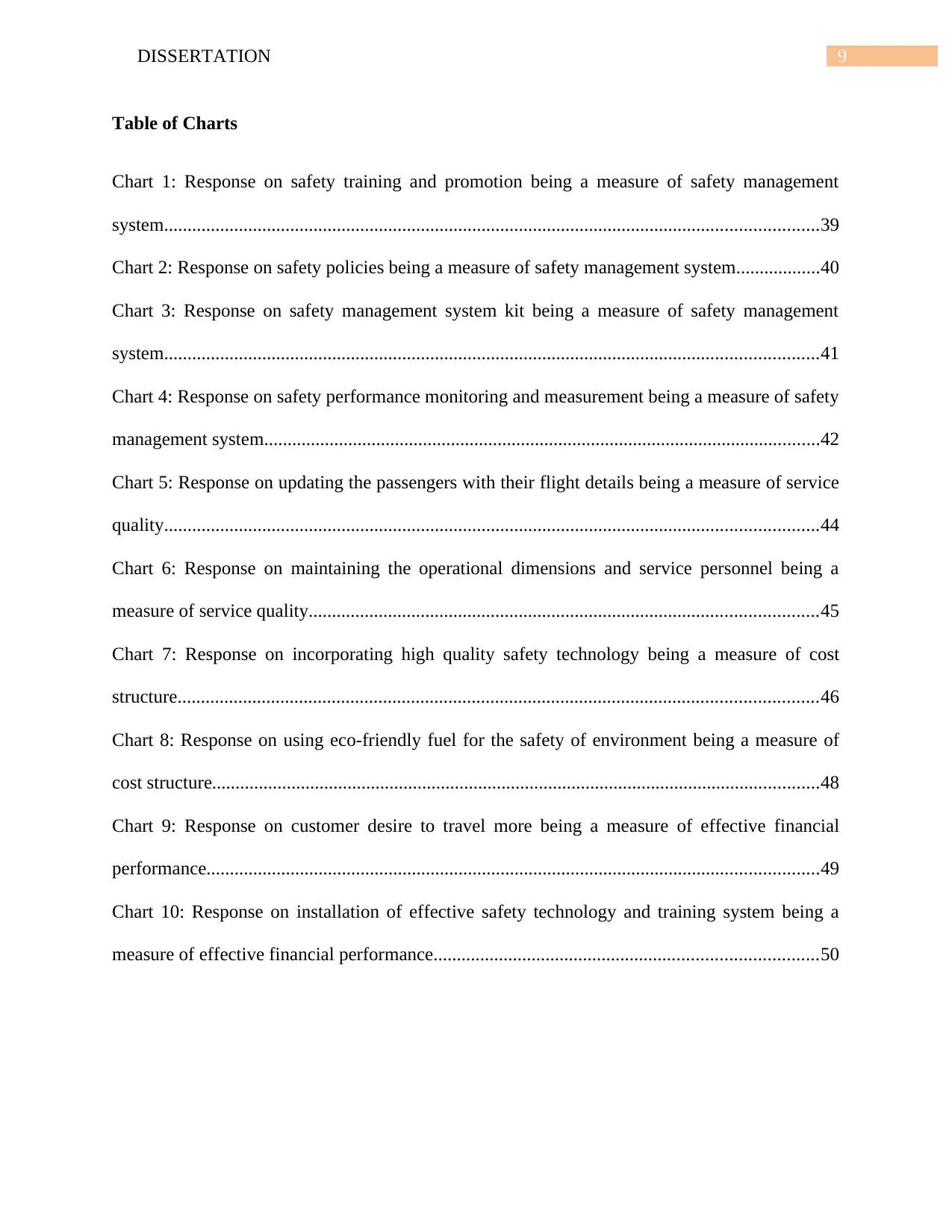
9DISSERTATION
Table of Charts
Chart 1: Response on safety training and promotion being a measure of safety management
system............................................................................................................................................39
Chart 2: Response on safety policies being a measure of safety management system..................40
Chart 3: Response on safety management system kit being a measure of safety management
system............................................................................................................................................41
Chart 4: Response on safety performance monitoring and measurement being a measure of safety
management system.......................................................................................................................42
Chart 5: Response on updating the passengers with their flight details being a measure of service
quality............................................................................................................................................44
Chart 6: Response on maintaining the operational dimensions and service personnel being a
measure of service quality.............................................................................................................45
Chart 7: Response on incorporating high quality safety technology being a measure of cost
structure.........................................................................................................................................46
Chart 8: Response on using eco-friendly fuel for the safety of environment being a measure of
cost structure..................................................................................................................................48
Chart 9: Response on customer desire to travel more being a measure of effective financial
performance...................................................................................................................................49
Chart 10: Response on installation of effective safety technology and training system being a
measure of effective financial performance..................................................................................50
Table of Charts
Chart 1: Response on safety training and promotion being a measure of safety management
system............................................................................................................................................39
Chart 2: Response on safety policies being a measure of safety management system..................40
Chart 3: Response on safety management system kit being a measure of safety management
system............................................................................................................................................41
Chart 4: Response on safety performance monitoring and measurement being a measure of safety
management system.......................................................................................................................42
Chart 5: Response on updating the passengers with their flight details being a measure of service
quality............................................................................................................................................44
Chart 6: Response on maintaining the operational dimensions and service personnel being a
measure of service quality.............................................................................................................45
Chart 7: Response on incorporating high quality safety technology being a measure of cost
structure.........................................................................................................................................46
Chart 8: Response on using eco-friendly fuel for the safety of environment being a measure of
cost structure..................................................................................................................................48
Chart 9: Response on customer desire to travel more being a measure of effective financial
performance...................................................................................................................................49
Chart 10: Response on installation of effective safety technology and training system being a
measure of effective financial performance..................................................................................50
Paraphrase This Document
Need a fresh take? Get an instant paraphrase of this document with our AI Paraphraser
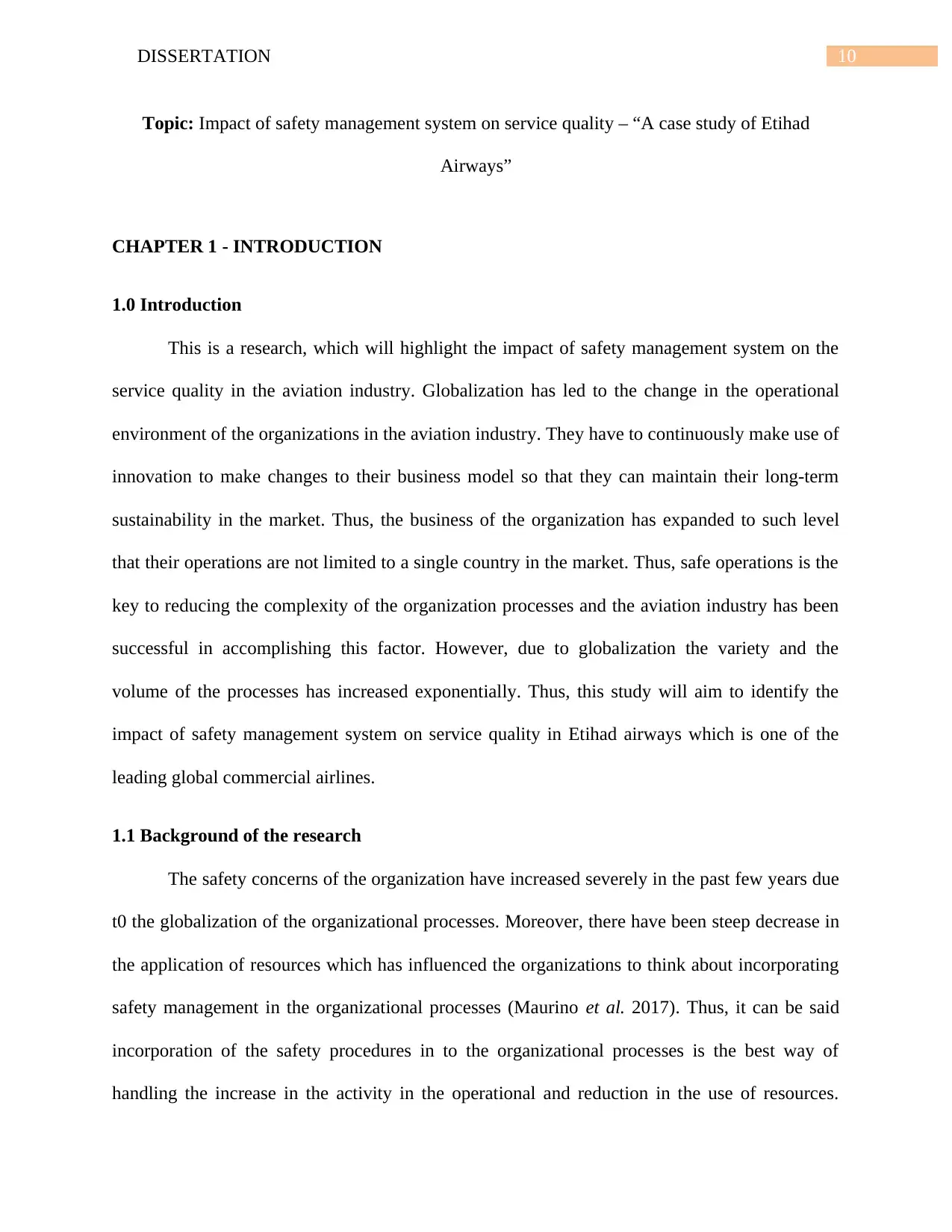
10DISSERTATION
Topic: Impact of safety management system on service quality – “A case study of Etihad
Airways”
CHAPTER 1 - INTRODUCTION
1.0 Introduction
This is a research, which will highlight the impact of safety management system on the
service quality in the aviation industry. Globalization has led to the change in the operational
environment of the organizations in the aviation industry. They have to continuously make use of
innovation to make changes to their business model so that they can maintain their long-term
sustainability in the market. Thus, the business of the organization has expanded to such level
that their operations are not limited to a single country in the market. Thus, safe operations is the
key to reducing the complexity of the organization processes and the aviation industry has been
successful in accomplishing this factor. However, due to globalization the variety and the
volume of the processes has increased exponentially. Thus, this study will aim to identify the
impact of safety management system on service quality in Etihad airways which is one of the
leading global commercial airlines.
1.1 Background of the research
The safety concerns of the organization have increased severely in the past few years due
t0 the globalization of the organizational processes. Moreover, there have been steep decrease in
the application of resources which has influenced the organizations to think about incorporating
safety management in the organizational processes (Maurino et al. 2017). Thus, it can be said
incorporation of the safety procedures in to the organizational processes is the best way of
handling the increase in the activity in the operational and reduction in the use of resources.
Topic: Impact of safety management system on service quality – “A case study of Etihad
Airways”
CHAPTER 1 - INTRODUCTION
1.0 Introduction
This is a research, which will highlight the impact of safety management system on the
service quality in the aviation industry. Globalization has led to the change in the operational
environment of the organizations in the aviation industry. They have to continuously make use of
innovation to make changes to their business model so that they can maintain their long-term
sustainability in the market. Thus, the business of the organization has expanded to such level
that their operations are not limited to a single country in the market. Thus, safe operations is the
key to reducing the complexity of the organization processes and the aviation industry has been
successful in accomplishing this factor. However, due to globalization the variety and the
volume of the processes has increased exponentially. Thus, this study will aim to identify the
impact of safety management system on service quality in Etihad airways which is one of the
leading global commercial airlines.
1.1 Background of the research
The safety concerns of the organization have increased severely in the past few years due
t0 the globalization of the organizational processes. Moreover, there have been steep decrease in
the application of resources which has influenced the organizations to think about incorporating
safety management in the organizational processes (Maurino et al. 2017). Thus, it can be said
incorporation of the safety procedures in to the organizational processes is the best way of
handling the increase in the activity in the operational and reduction in the use of resources.

11DISSERTATION
Thus, safety management is essential for maintaining the relevance and viability of the
organizational procedures. Thus, the use of innovation into the business model of the
organization in the aviation industry can be put together in better way and be called as safety
management system.
The approach of managing quality in order to control the risk procedure in the
organization can be termed as safety management system. Thus, the safety management system
will facilitate in establishing sound culture for the management so that it can provide support to
the organizational framework. Thus, the core processes of safety for the organization is managed
by the safety management system and for the airlines it can also be an effective of
communicating with officers providing FAA certificate. Moreover, safety management system
provides the organization with the road map of managing organization’s safety management
processes in a detailed manner (Halford 2016). Safety management system not only helps the
organization to manage the legal obligations of the organization but also facilitates in gaining
benefits. The inclusion of the safety management system enables the organization incorporate
quality assurance and internal evaluation which will continuously improve the operational
procedures. Various researches suggest that the use of the safety management system has
assisted in making continuous improvement in the organizational operational procedures that has
benefited the organization at a financial level.
Various studies have stated that accidents are result of human error and changing people
is not a feasible solution for the organization. Thus, comes in to play the safety management
system which is used to identify the factors that are the cause of the accident. Therefore,
remedial actions can be taken so these circumstances can be avoided by the organization. Thus,
ensuring safety should be the top priority for the organizations in this industry. Safety
Thus, safety management is essential for maintaining the relevance and viability of the
organizational procedures. Thus, the use of innovation into the business model of the
organization in the aviation industry can be put together in better way and be called as safety
management system.
The approach of managing quality in order to control the risk procedure in the
organization can be termed as safety management system. Thus, the safety management system
will facilitate in establishing sound culture for the management so that it can provide support to
the organizational framework. Thus, the core processes of safety for the organization is managed
by the safety management system and for the airlines it can also be an effective of
communicating with officers providing FAA certificate. Moreover, safety management system
provides the organization with the road map of managing organization’s safety management
processes in a detailed manner (Halford 2016). Safety management system not only helps the
organization to manage the legal obligations of the organization but also facilitates in gaining
benefits. The inclusion of the safety management system enables the organization incorporate
quality assurance and internal evaluation which will continuously improve the operational
procedures. Various researches suggest that the use of the safety management system has
assisted in making continuous improvement in the organizational operational procedures that has
benefited the organization at a financial level.
Various studies have stated that accidents are result of human error and changing people
is not a feasible solution for the organization. Thus, comes in to play the safety management
system which is used to identify the factors that are the cause of the accident. Therefore,
remedial actions can be taken so these circumstances can be avoided by the organization. Thus,
ensuring safety should be the top priority for the organizations in this industry. Safety
⊘ This is a preview!⊘
Do you want full access?
Subscribe today to unlock all pages.

Trusted by 1+ million students worldwide
1 out of 70